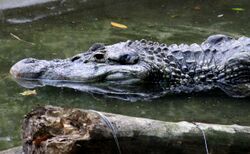Biology:Melanosuchus
| Melanosuchus | |
|---|---|

| |
| Scientific classification | |
| Domain: | Eukaryota |
| Kingdom: | Animalia |
| Phylum: | Chordata |
| Class: | Reptilia |
| Clade: | Archosauromorpha |
| Clade: | Archosauriformes |
| Order: | Crocodilia |
| Family: | Alligatoridae |
| Subfamily: | Caimaninae |
| Clade: | Jacarea |
| Genus: | Melanosuchus Gray, 1862 |
| Species | |
| |
Melanosuchus is a genus of caiman. The black caiman of South America is the sole extant (living) species, and is the largest living member of the subfamily Caimaninae, as well as the entire alligator family Alligatoridae.
Taxonomy
Extant species
There is one extant species:
- Melanosuchus niger (Spix, 1825) - known as the Black caiman, native to the Amazon basin of South America
Fossil species
Fossil species are known from the Late Miocene of South America and include:
- Melanosuchus latrubessei Souza-Filho et al, 2020 - discovered in the Solimões Formation of Brazil , dating from the Upper Miocene[1]
- Melanosuchus fisheri Medina, 1976 - from the Urumaco Formation of Venezuela, dating from the Late Miocene, but now considered as nomen dubium[1][2]
Phylogeny
Melanosuchus is a member of the subfamily Caimaninae, which contains the two other extant genera Caiman and Paleosuchus, all of which are native to South and Central America. The below cladogram shows the relationships of all extant genera within Crocodilia (excluding separate extinct taxa), based on molecular phylogenetic studies.[3][4][5][6]
| Crocodilia |
| ||||||||||||||||||||||||||||||||||||||||||||||||
References
- ↑ 1.0 1.1 Souza-Filho, J.P. (2020). "On a new Melanosuchus species (Alligatoroidea: Caimaninae) from Solimões Formation (Eocene-Pliocene), Northern Brazil, and evolution of Caimaninae". Zootaxa 4894 (4): 561–593. doi:10.11646/zootaxa.4894.4.5. PMID 33311064. https://igeo.ufrj.br/inc/isc/3/3_87-Souza_Filho_etal_2020_Melanosuchus_latrubessei.pdf.
- ↑ Bona, Paula; Blanco, M. Victoria Fernandez; Schever, Torsten M.; Both, Christian (2017). "Shedding Light on the Taxonomic Diversity of the South American Miocene Caimans: The Status of Melanosuchus fisheri (Crocodylia, Alligatoroidea)". Ameghiniana 54 (6): 681–687. doi:10.5710/AMGH.08.06.2017.3103. http://naturalis.fcnym.unlp.edu.ar/repositorio/_documentos/sipcyt/bfa006078.pdf.
- ↑ Michael S. Y. Lee; Adam M. Yates (27 June 2018). "Tip-dating and homoplasy: reconciling the shallow molecular divergences of modern gharials with their long fossil". Proceedings of the Royal Society B 285 (1881). doi:10.1098/rspb.2018.1071. PMID 30051855.
- ↑ Hekkala, E.; Gatesy, J.; Narechania, A.; Meredith, R.; Russello, M.; Aardema, M. L.; Jensen, E.; Montanari, S. et al. (2021-04-27). "Paleogenomics illuminates the evolutionary history of the extinct Holocene "horned" crocodile of Madagascar, Voay robustus" (in en). Communications Biology 4 (1): 505. doi:10.1038/s42003-021-02017-0. ISSN 2399-3642. PMID 33907305.
- ↑ Rio, Jonathan P.; Mannion, Philip D. (6 September 2021). "Phylogenetic analysis of a new morphological dataset elucidates the evolutionary history of Crocodylia and resolves the long-standing gharial problem". PeerJ 9: e12094. doi:10.7717/peerj.12094. PMID 34567843.
- ↑ Gatesy, J.; Amato, G. (2008). "The rapid accumulation of consistent molecular support for intergeneric crocodylian relationships". Molecular Phylogenetics and Evolution 48 (3): 1232–1237. doi:10.1016/j.ympev.2008.02.009. PMID 18372192.
Wikidata ☰ Q2080580 entry
 |

